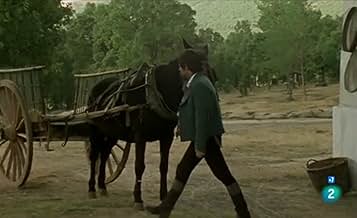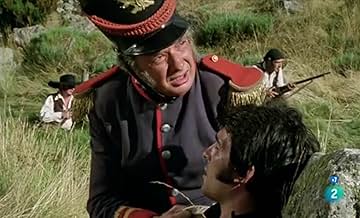Ambientadas en la España del siglo XIX, las aventuras en el sur del bandolero Curro Jimenez, el Robin Hood español.Ambientadas en la España del siglo XIX, las aventuras en el sur del bandolero Curro Jimenez, el Robin Hood español.Ambientadas en la España del siglo XIX, las aventuras en el sur del bandolero Curro Jimenez, el Robin Hood español.
- Premios
- 3 premios ganados y 2 nominaciones en total
Explorar episodios
Argumento
¿Sabías que…?
- TriviaThe protagonist was loosely based on a real-life character, the 19th century bandit Francisco "Curro" López Jiménez. They mainly borrowed his nickname and little else, as most of the events and characters were made up by the screenwriters, and even the historic period is not consistent with that of the real Curro Jiménez.
- ConexionesFeatured in Spanish Western (2014)
Opinión destacada
Some twenty years after José María Forqué's masterpiece "Amanecer en Puerta Oscura", and twelve years after Mario Camus' "Llanto por un Bandido", came "Curro Jiménez" which would become the undisputed cornerstone of the so-called Andalusian Western.
This excellent TV series run in Televisión Española (the Spanish national public network) for three seasons (1976-79).
Its main character was loosely based in real-life bandolero Francisco "Curro" Jiménez Ledesma, from whom it barely took his name and little else, as most of the characters and events depicted were made up by the screenwriters and even the historic period was not consistent with that of the real Curro.
Curro Jiménez's gang lived a different adventure each episode, even though some of them took two, and the pilot was longer (and sometimes confused with the spin-off film), such a band was composed of Curro (Sancho Gracia) and his partners: el Estudiante ("the Student" Pepe Sancho), el Algarrobo (Álvaro de Luna) and el Fraile ("the Monk"), the latter was substituted by a new one, el Gitano ("the Gypsy" Eduardo García), when the actor who played it, Paco Algora left the show seeking (unsuccessfully) a better acting career playing main roles in cinema.
Being shot during the political transition between a military dictatorship and a democracy in Spain, the series was set in the 19th century, thus Curro and his men's struggle against the French invaders during the Spanish Independence War, and afterwards against the rural feuds, mirrored the struggle of the Spanish people themselves.
All the technical and artistic features: cinematography, music (unforgettable tune), acting etc were impeccable.
In its time the series made famous the actors who played its protagonists, as it was very popular in Spain and all over South America, giving birth to a couple of spin-offs.
In all, I guess to an American audience it must look like a mixture between El Zorro, "For a Fistful of Dollars", "the Magnificent Seven" and "The Wild Bunch", with a 19th century Southern Spanish setting.
In my opinion it was a great, funny, enjoyable, entertaining and action-packed show, I hope you will enjoy Curro's adventures, robbing stagecoaches, assaulting French military headquarters and being pursued by ruthless lawmen, as much as I did in my childhood.
If you already watched it and enjoyed it do not miss the above mentioned "Amanecer en Puerta Oscura" and "Llanto por un Bandido" and, of course, "Avisa a Curro Jiménez" (also known as "Curro Jiménez, the Movie"), and avoid at all costs its awful 1990s sequel "Curro Jiménez II: El Regreso de una Leyenda".
This excellent TV series run in Televisión Española (the Spanish national public network) for three seasons (1976-79).
Its main character was loosely based in real-life bandolero Francisco "Curro" Jiménez Ledesma, from whom it barely took his name and little else, as most of the characters and events depicted were made up by the screenwriters and even the historic period was not consistent with that of the real Curro.
Curro Jiménez's gang lived a different adventure each episode, even though some of them took two, and the pilot was longer (and sometimes confused with the spin-off film), such a band was composed of Curro (Sancho Gracia) and his partners: el Estudiante ("the Student" Pepe Sancho), el Algarrobo (Álvaro de Luna) and el Fraile ("the Monk"), the latter was substituted by a new one, el Gitano ("the Gypsy" Eduardo García), when the actor who played it, Paco Algora left the show seeking (unsuccessfully) a better acting career playing main roles in cinema.
Being shot during the political transition between a military dictatorship and a democracy in Spain, the series was set in the 19th century, thus Curro and his men's struggle against the French invaders during the Spanish Independence War, and afterwards against the rural feuds, mirrored the struggle of the Spanish people themselves.
All the technical and artistic features: cinematography, music (unforgettable tune), acting etc were impeccable.
In its time the series made famous the actors who played its protagonists, as it was very popular in Spain and all over South America, giving birth to a couple of spin-offs.
In all, I guess to an American audience it must look like a mixture between El Zorro, "For a Fistful of Dollars", "the Magnificent Seven" and "The Wild Bunch", with a 19th century Southern Spanish setting.
In my opinion it was a great, funny, enjoyable, entertaining and action-packed show, I hope you will enjoy Curro's adventures, robbing stagecoaches, assaulting French military headquarters and being pursued by ruthless lawmen, as much as I did in my childhood.
If you already watched it and enjoyed it do not miss the above mentioned "Amanecer en Puerta Oscura" and "Llanto por un Bandido" and, of course, "Avisa a Curro Jiménez" (also known as "Curro Jiménez, the Movie"), and avoid at all costs its awful 1990s sequel "Curro Jiménez II: El Regreso de una Leyenda".
- jfsandin
- 31 oct 2006
- Enlace permanente
Selecciones populares
Inicia sesión para calificar y agrega a la lista de videos para obtener recomendaciones personalizadas
- How many seasons does Curro Jiménez have?Con tecnología de Alexa
Detalles
Contribuir a esta página
Sugiere una edición o agrega el contenido que falta

Principales brechas de datos
What is the English language plot outline for Curro Jiménez (1976)?
Responda



























